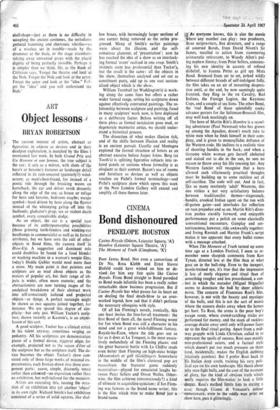Object lessons e
A ITT BRYAN ROBERTSON
The current interest of artists, abstract or figurative, in objects as devices and in their deadpan exploration, is matched by the films I mentioned last week. In both Grand Prix and Un Homme et une femme, the true subject is the car: it acts as a mirror, with shots of-tke hero's or heroine's features or landscape detail reflected in its rain-smeared (painterly?) wind- screen; as man's-best-friend, for instead of a poetic ride through the breaking waves on horseback, the car and driver swish dreamily along the edge of the sea; as house or refuge for hero and heroine, bedroom maybe; escape symbol—hard driven by hero along the flyover instead of the whinnying gallop off into the badlands; gladiator's prop; sex or violent death symbol, every conceivable dodge.
As an object, the car is a special case because of its anthropomorphic possibilities (those grinning teeth-fenders and winking-eye headlamps in commercials) as well as itt formal attributes, but we have seen the cult of other objects in Bond films, the camera itself in Blow-Up. A suggestive and dominant role could doubtless be found for a food blender or washing machine in a woman's weepie film; today's Hedda Gabler would need more than a stove. My main point is that painters and sculptors are as mad about objects as the makers of popular art, but their range of 'ob- jects is wider, often more esoteric; and the abstractionists are now turning stages of the analytical breakdown of their abstract work into self-consciously isolated and projected objects—or things. A perfect rectangle might be shown as two squares joined together, for instance. We are spared this degree of sim- plicity—but only just. William Tucker's sculp- ture, shown recently at Kasmin's, is an objett- lesson of this sort.
A good sculptor, Tucker has a clinical streak in his talent anyway, sometimes verging on pedantry. All his sculptures are demonstration pieces of a formal device, ziggurat edges for example, projected not as the raison d'être of the sculpture but as the sculpture itself. The de- vice becomes the object. Tucker's show con- sisted only of three large works of minimal ex- pressiveness, each broken down into three com- ponent parts: suave, simple, discreetly toned rather than coloured—an exposition rather than an exhibition, but well-tailored for the occasion.
Artists are extending this, turning the occa- sion of an exhibition into yet another 'object' in its own right. Richard Smith's last exhibition consisted of a series of solid squares, like shal- low boxes, with increasingly larger sections of one corner being removed as the series pro- gressed. Many of Smith's earlier paintings were about the illusion, and the self- conscious glamour, of 'presentation': now he has reached the idea of a show as an interlock- ing formal 'event' realised in one coup. Smith's instincts seem less professorial than Tucker's, but the result is the same: all the objects in the show, themselves analysed and set out as constituent parts, add up to one vast section- alised object which is the show.
William Turnbull (at Waddington's) is work- ing along the same lines but offers a rather wider formal range, setting his sculptures down against effectively contrasted paintings. The re- lationship between sculpture and painting, fused in many sculptors' work now, is here deployed as a deliberate factor. Before writing off all these ploys as formal narcissism gone mad, or degenerate mannerist antics, we should under- stand a historical process.
The dissection of what makes illusion tick, and of the shifts between illusion and reality is an ancient pursuit. Uccello and Mantegna explored the formal structure of letters as an abstract exercise before Jasper Johns. Berg (at Tooth's) is splitting figurative subjects into re- lated panels or sections whose formality is as eloqbent as their content. Bacon's use of rooms and furniture as devices as well as objects touches on Pichd's formal terminology—and Pieties sculpture show which opens this week at the New London Gallery will extend and amplify all these themes later.






































 Previous page
Previous page